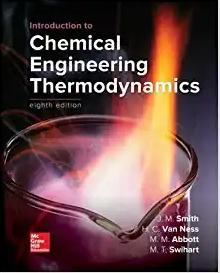Answered step by step
Verified Expert Solution
Question
1 Approved Answer
Complete the following for the reaction below. You may solve by hand, Excel, Mathematica, Matlab, or any other program ( s ) of your choice.
Complete the following for the reaction below. You may solve by hand, Excel, Mathematica, Matlab, or any other programs of your choice. Your solution can be approximate ie just like the examples in chapter of the book ; constant a Plot the equilibrium conversion as a function of temperature like in Figure E APPROACH: This is a pretty straightforward relationship. The equation is given in chapter and there is a near identical example. b Estimate the minimum volume PFR required to achieve conversion of A like Example A is fed into the reactor at and APPROACH: This is a bit more complex. Since the plot from example does not apply, I recommend the following steps to solving this: Select specific conversions ie Setup the equation for as a function of and using a stoichiometric table and Arrhenius' equation. For each conversion in step calculate the that will maximize rate using something like Wolfram Alpha. Keep in mind that this is an aqueous reaction. This will give you a table of rates at each conversion. You can calculate the volume for the PFR using the graphical approach described when we were originally covering ideal reactors. c What is the necessary inlet temperature for a minimum volume adiabatic CSTR operating at conversion? APPROACH: Use the approach described above to determine the optimal temperature for the CSTR Calculate the inlet temperature using the heat of reaction and specific heat as described in chapter 
Complete the following for the reaction below. You may solve by hand, Excel, Mathematica, Matlab, or
any other programs of your choice. Your solution can be approximate ie just like the examples in
chapter of the book
;
constant
a Plot the equilibrium conversion as a function of temperature like in Figure E
APPROACH: This is a pretty straightforward relationship. The equation is given in chapter
and there is a near identical example.
b Estimate the minimum volume PFR required to achieve conversion of A like Example A
is fed into the reactor at and
APPROACH: This is a bit more complex. Since the plot from example does not apply, I
recommend the following steps to solving this:
Select specific conversions ie
Setup the equation for as a function of and using a stoichiometric table and
Arrhenius' equation.
For each conversion in step calculate the that will maximize rate using something
like Wolfram Alpha. Keep in mind that this is an aqueous reaction.
This will give you a table of rates at each conversion. You can calculate the volume for
the PFR using the graphical approach described when we were originally covering ideal
reactors.
c What is the necessary inlet temperature for a minimum volume adiabatic CSTR operating at
conversion?
APPROACH: Use the approach described above to determine the optimal temperature for
the CSTR Calculate the inlet temperature using the heat of reaction and specific heat as
described in chapter
Step by Step Solution
There are 3 Steps involved in it
Step: 1

Get Instant Access to Expert-Tailored Solutions
See step-by-step solutions with expert insights and AI powered tools for academic success
Step: 2

Step: 3

Ace Your Homework with AI
Get the answers you need in no time with our AI-driven, step-by-step assistance
Get Started


